There are many vantage points around the UK where you can observe whales, dolphins and porpoises from the coast lines of Cornwall and Dorset to the Isle of Skye.
With the large number of different species of whales, dolphins and porpoises there comes a wide range of skills, breeding patterns, feeding habits and more. This allows nearly every aquatic environment to be suitable for a different species of whales, dolphins or porpoises.
What are the differences between whales, dolphins and porpoises?
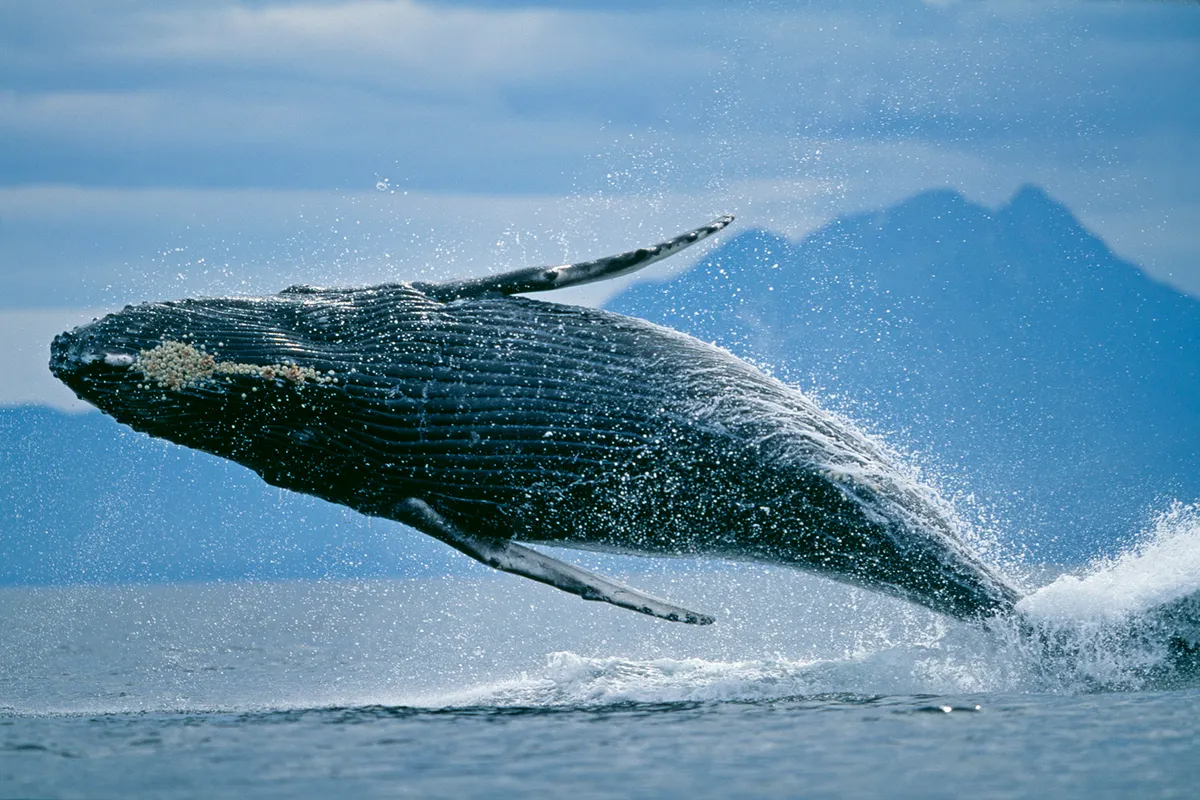
Collectively, whales, dolphins and porpoises are known as cetaceans. The species are divided into two groups.
- Baleen whales – these are the “great whales” and as their name suggests they all have baleen plates that are used to filter their food (which consists of plankton and small species of fish).
- Toothed whales (otherwise known as odontocetes and including all species of dolphin and porpoise) – which as you would expect, have teeth, and eat larger prey items, including at times, other marine mammals. The main differences with porpoises are that they are usually smaller than other toothed whales and instead of cone-shaped teeth they have flat, spade-shaped teeth.
As a general rule of thumb, baleen whales are larger and slower (except the fin whale which is known as the “greyhound of the sea”) than toothed whales. Additionally, all baleen whales have two blowholes whereas toothed whales only have one.
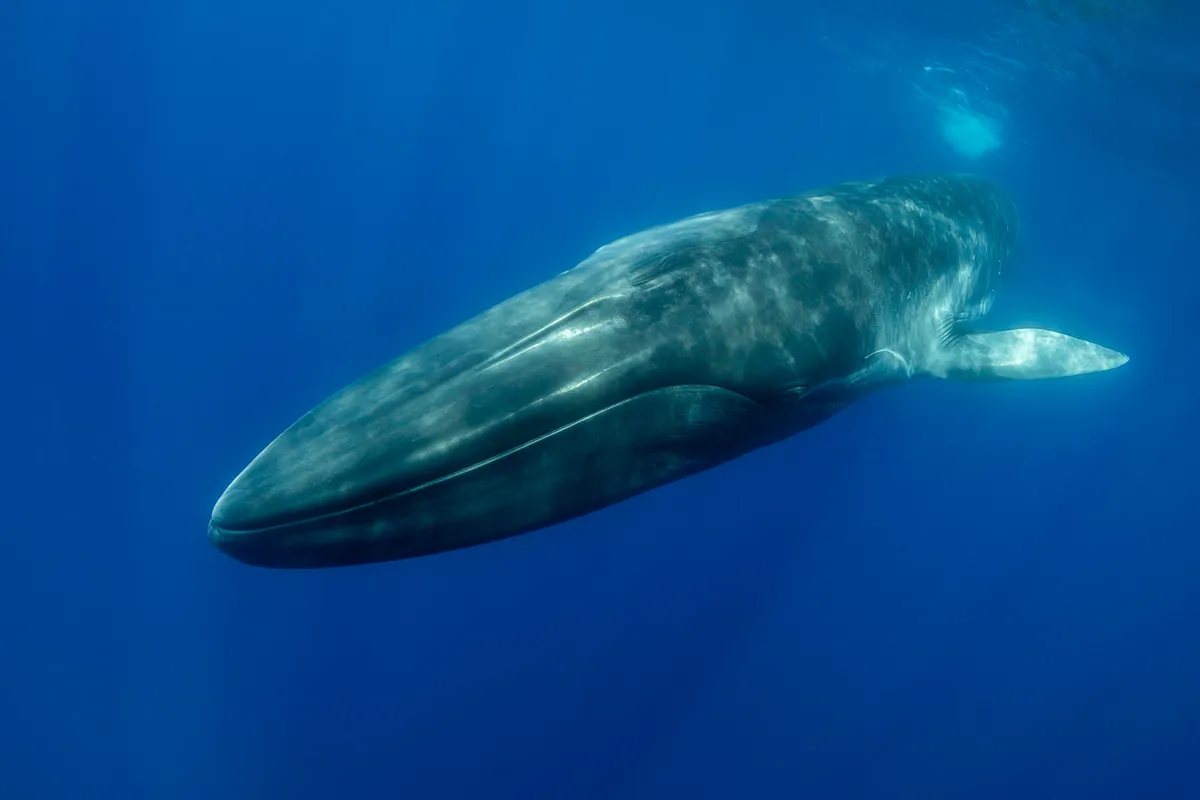
One of the biggest differences between a dolphin and a porpoise is the size. All species of porpoise are much smaller than their dolphin cousins. Porpoises don't have the pronounced beak that most, but not all, dolphins have and they also have different shaped teeth: porpoise teeth are spade-shaped whilst dolphins are conical.
A dolphin's dorsal fin (if it has one) is hooked or curved, whereas a porpoise has a more triangular dorsal fin, and generally speaking, dolphin bodies are leaner, although porpoises’ are a little more chunky.
Dolphins are also more "talkative" than porpoises. The whistles made by dolphins are produced through their blowholes and although porpoises do not do this, possibly due to structural differences in the porpoise’s blowhole, they can still be pretty noisy as they "puff" the air out when they surface.
Dolphins and porpoises also have many similarities, one of which is their extreme intelligence. As research evolves, it is likely that more (or perhaps fewer) differences between dolphins and porpoises will be revealed.
How many species of whales, dolphins and porpoises are there?
The Society for Marine Mammology – they are the recognised authority on ‘species’ (IUCN are the recognised authority on ‘status’) –currently recognises 92 species, one of which may be extinct.
Which species of whales, dolphins and porpoises are seen in UK waters?
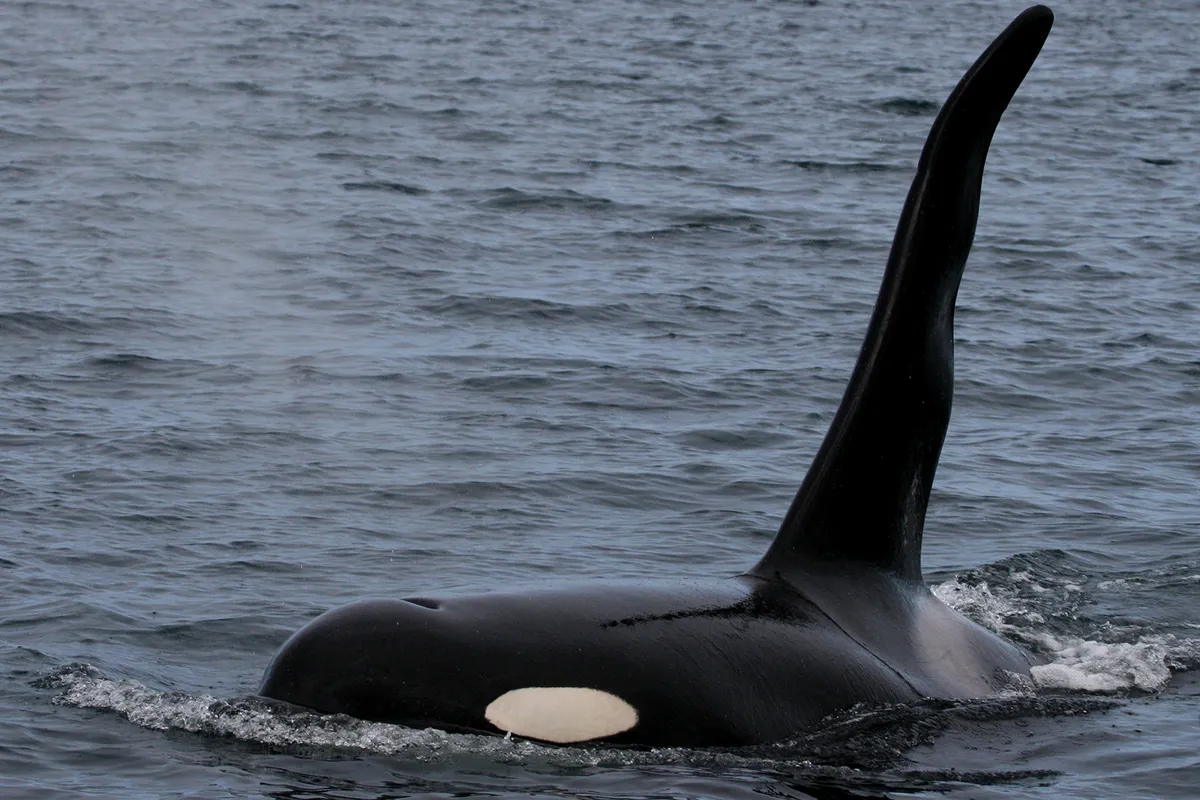
At least 28 of the globally recognized species of cetaceans have been reported in UK waters however some of these have had relatively few sightings.
Some of the more common species include, harbour porpoise, bottlenose dolphin, Risso’s dolphin, common dolphin, Atlantic white-sided dolphin, white-beaked dolphin, minke whale, humpback whale, long-finned pilot whale, fin whale, orca, various beaked whale species.
The main species found in UK waters are:
Harbour porpoise (Phocoena phocoena)
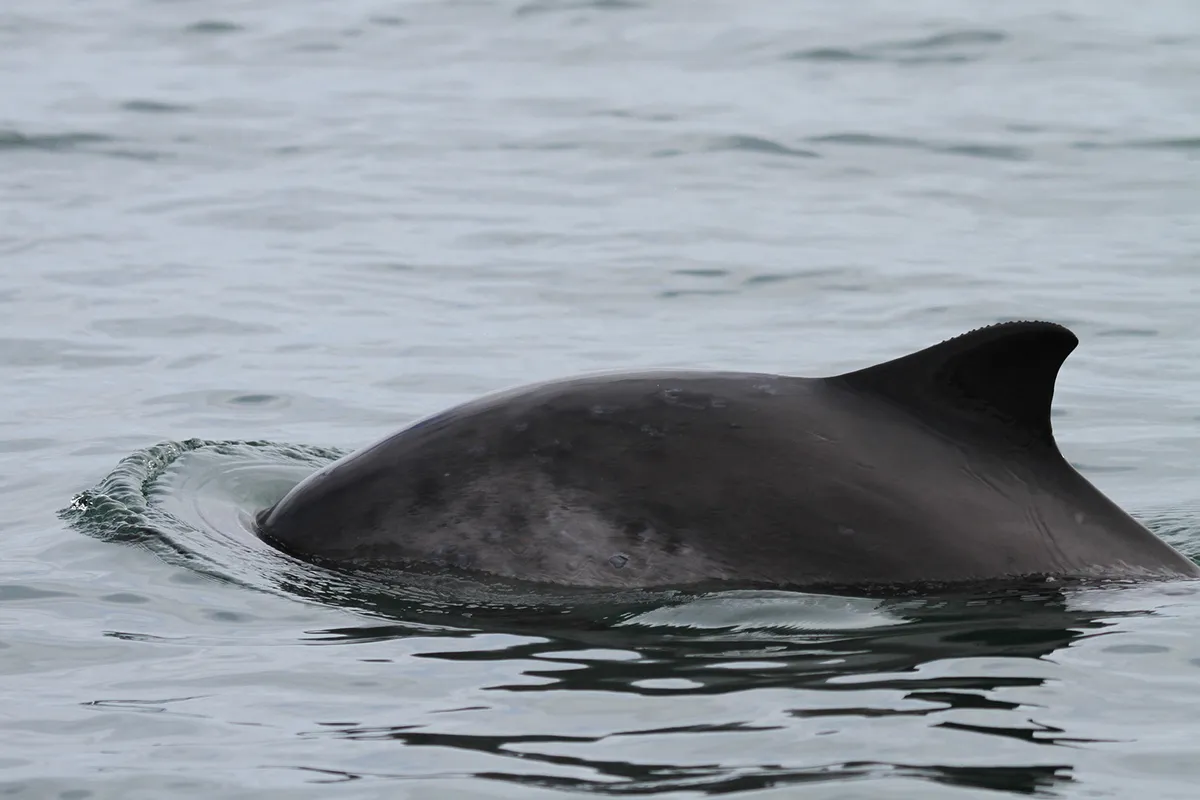
Harbour porpoises are relatively small compared to other dolphins, growing to just under 2m. They have small, rounded heads with no beak and dark lips and chin.
A shy creature, the porpoise eat mainly small schooling fish. The English word ‘porpoise' is derived from the Latin word for pig – porcus.
Rather unflatteringly, the harbour porpoise used to be known as the 'puffing pig', because of the sneeze-like puffing sound they make when they breathe. In the UK they are particularly at risk from bycatch – entanglement in fishing nets and gear.
The harbour porpoise’s scientific name, Phocoena phocoena, is an example of a tautonym, where the genus and specific name are the same.
Bottlenose dolphin (Tursiops truncatus)
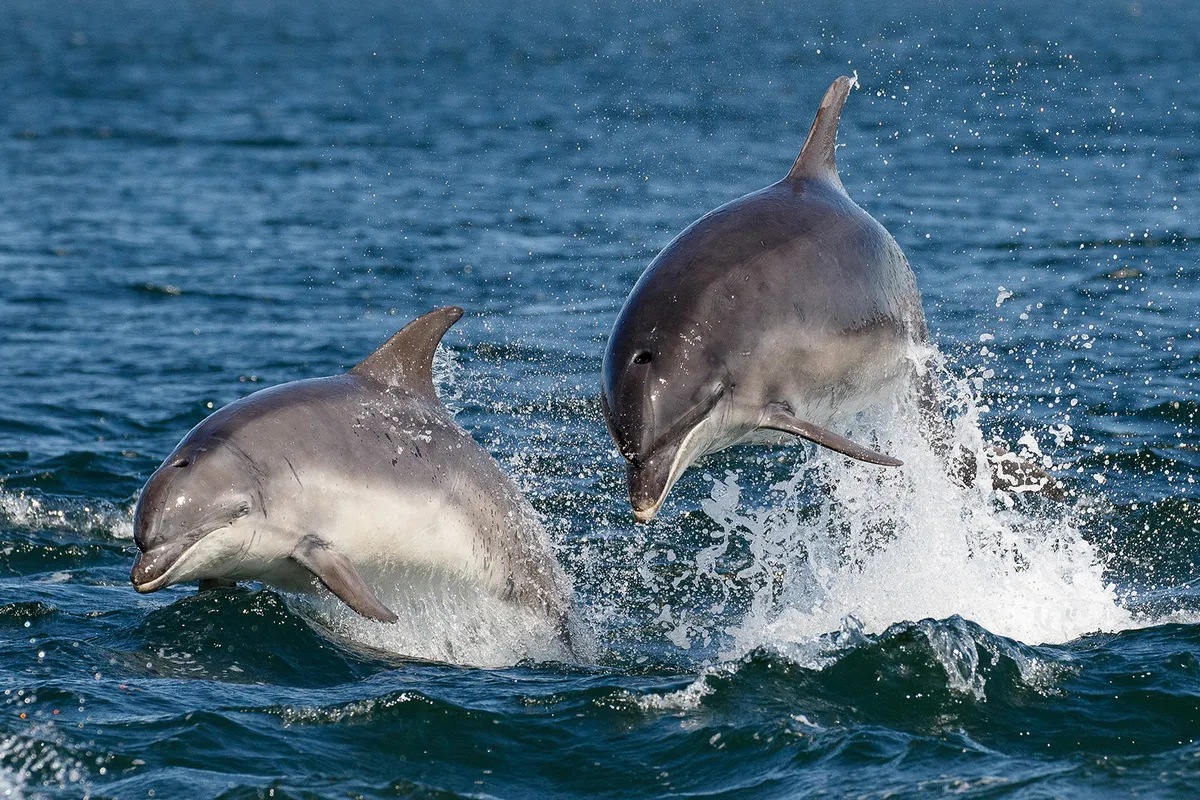
Common bottlenose dolphins have one of the most sophisticated intellects on our planet.
Exploited by the ‘entertainment’ industry for years, common bottlenose dolphins are the most widely recognised species of dolphin.
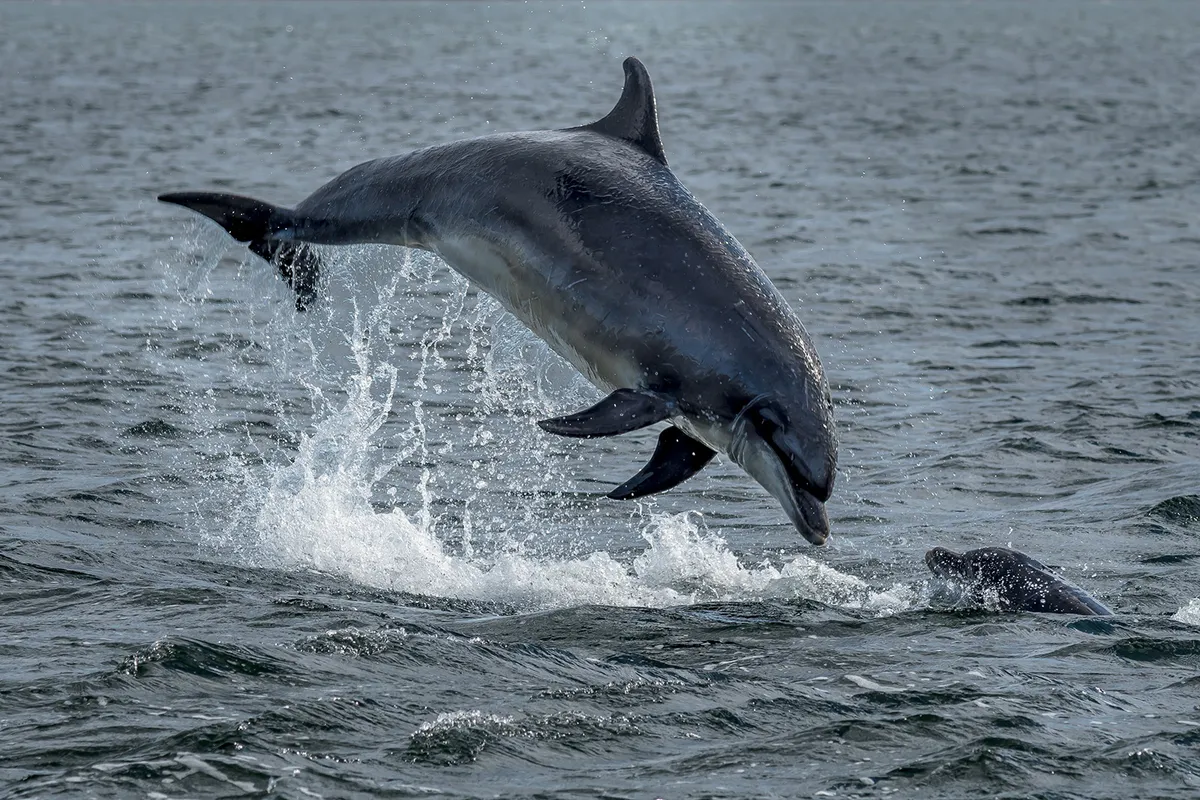
They eat a range of prey depending on where they are across the globe, and can grow to nearly 4m in length. Individuals can be recognised by distinct notches and markings on their dorsal fin, as unique as our fingerprints.
Risso’s dolphin (Grampus griseus)
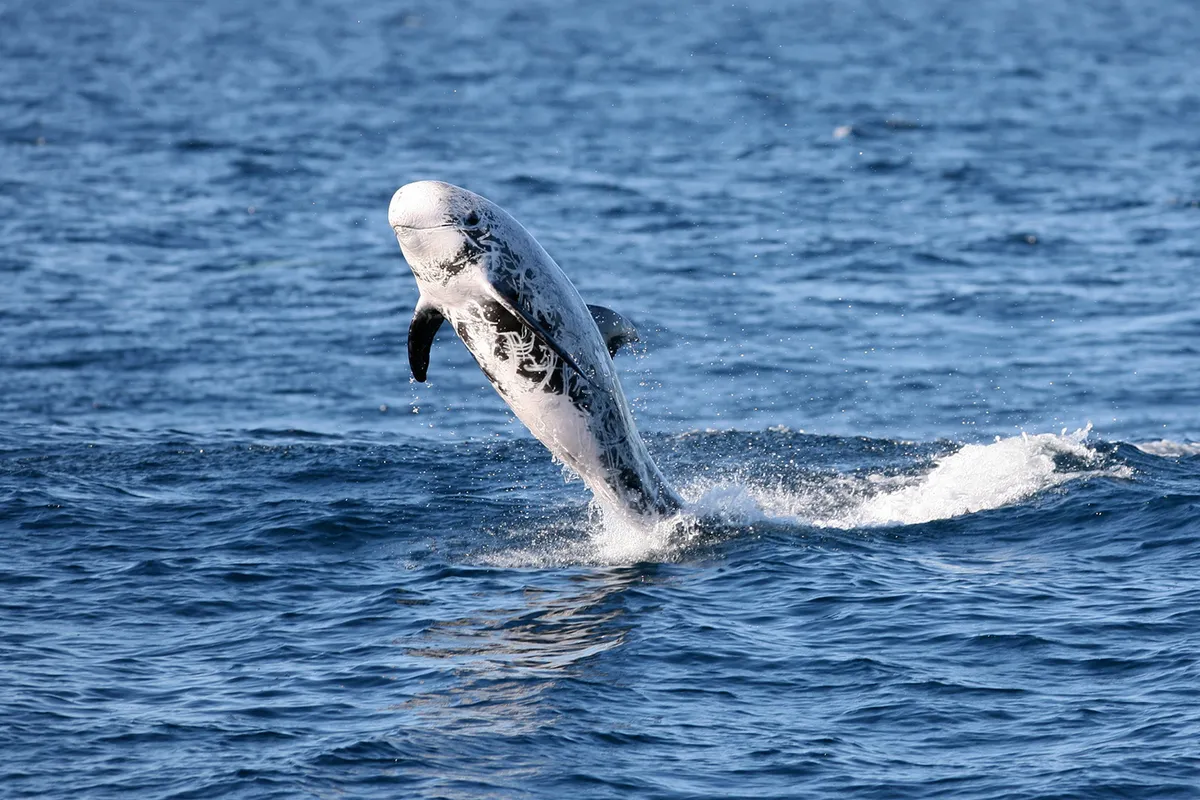
Growing to around 4m in length, Risso’s are quite different in appearance to any other dolphins. They are very stocky dolphins with blunt heads and no discernible beak.
Although they start out in life a grey/olive brown colour, as they get older they get whiter and whiter – a result of numerous scars and scratches from other Risso’s dolphins and their favourite food, squid
Please note that external videos may contain ads:
Risso's Dolphins - Bardsey Island, Wales © Whale and Dolphin Conservation
Minke whale (Balaenoptera acutorostrata)

The common minke whale is the smallest of all baleen whales, reaching around 8 to 9 metres long. They have between 50 and 70 expandable pleats that run from their throats to their flippers.
These pleats expand to take in huge mouthfuls of water and fish that are then sieved through the whales’ baleen plates. Around 20 to 30cm long, the plates hang down from the whale’s upper jaws like a thick-bristled brush and allow them to ingest the food they need.
Minke whales are content in their own company and tend to be quite solitary.
Please note that external videos may contain ads:
WDC Shorewatch - looking out for whales and dolphins in Scotland | Whale and Dolphin Conservation
What are groups of whales, dolphins and porpoises called?
The collective noun for groups of whales, dolphins and porpoises is the same: a pod.
Where can you see whales, dolphins and porpoises in UK waters?
Best spots are where pods are resident or frequent visitors. Tiumpan Head, Isle of Lewis; Chanonry Point (and other spots), Moray Firth; Neist Point, Skye; Cardigan Bay and Anglesey, Wales; Isle of Man; Dorset and Cornwall coast line.
Do whales, dolphins and porpoises come to UK waters at certain times of the year?
Many species, like the harbour porpoise, can be seen from the coast throughout the year. Much depends on which coast for sightings of other species who also reside year round in UK waters.
Other species are still present in UK waters but are known to stay further offshore. Some are seasonal visitors, like minke whales and humpbacks.
Are any of the whales, dolphins and porpoises found in UK waters endangered?
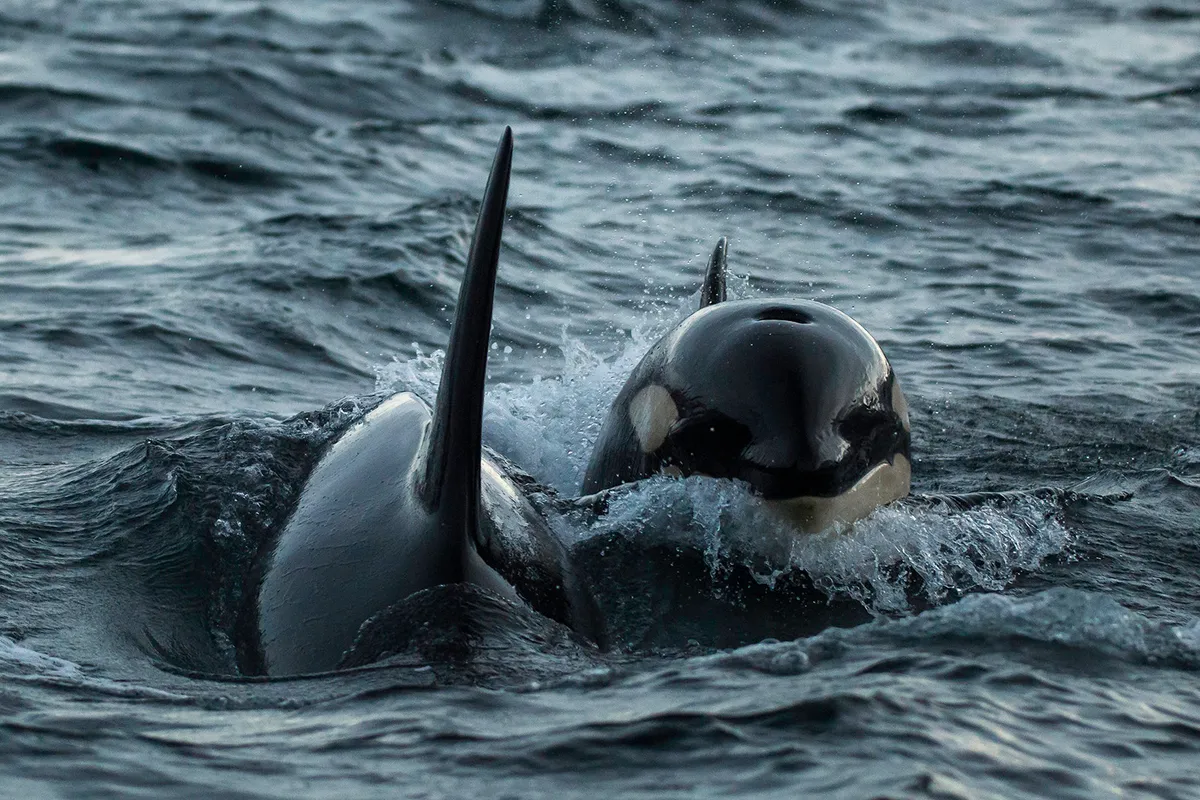
Yes, the west coast orca community, with less than 10 individuals.
What dangers do the whales, dolphins and porpoises in UK waters face?
They face many threats in UK waters, sadly most are man-made.
These include the biggest single killer of cetaceans worldwide – bycatch (accidental capture in fishing nets and gear).
They are also threatened by ocean pollution – plastic and chemical, plus noise pollution caused by underwater exploration for oil and gas, pile driving for wind turbines and military activity.
Whales and dolphins live in a world of sound, using their own echo-location to navigate, find prey, socialise and breed. When we disturb that world with high levels of noise, then we put them at risk.
Do whales, dolphins and porpoises breed in UK waters?
Yes, absolutely. All species regularly recorded in UK waters are known to breed and raise their young in UK waters.
When do whales, dolphins and porpoises breed?
Depending on the species, the average gestation period for whales ranges between 10 – 18 months. For dolphins, between 10 months (harbour porpoise) and 18 months (orcas), again depending on the species.
Worldwide, calves are born throughout the year. Birthing season is dependent on geographical location and calves could be born in all seasons, but peaks occur during spring, early summer and autumn.
All species will only have one calf at a time, and again the frequency of pregnancies is dependant on many factors (species, age, calf survival etc.) but is usually between 3 and 5 years.
What are the young of whales, dolphins and porpoises called?
The young of whales, dolphins and porpoises are know as calves.
How do whales, dolphins and porpoises feed their young?
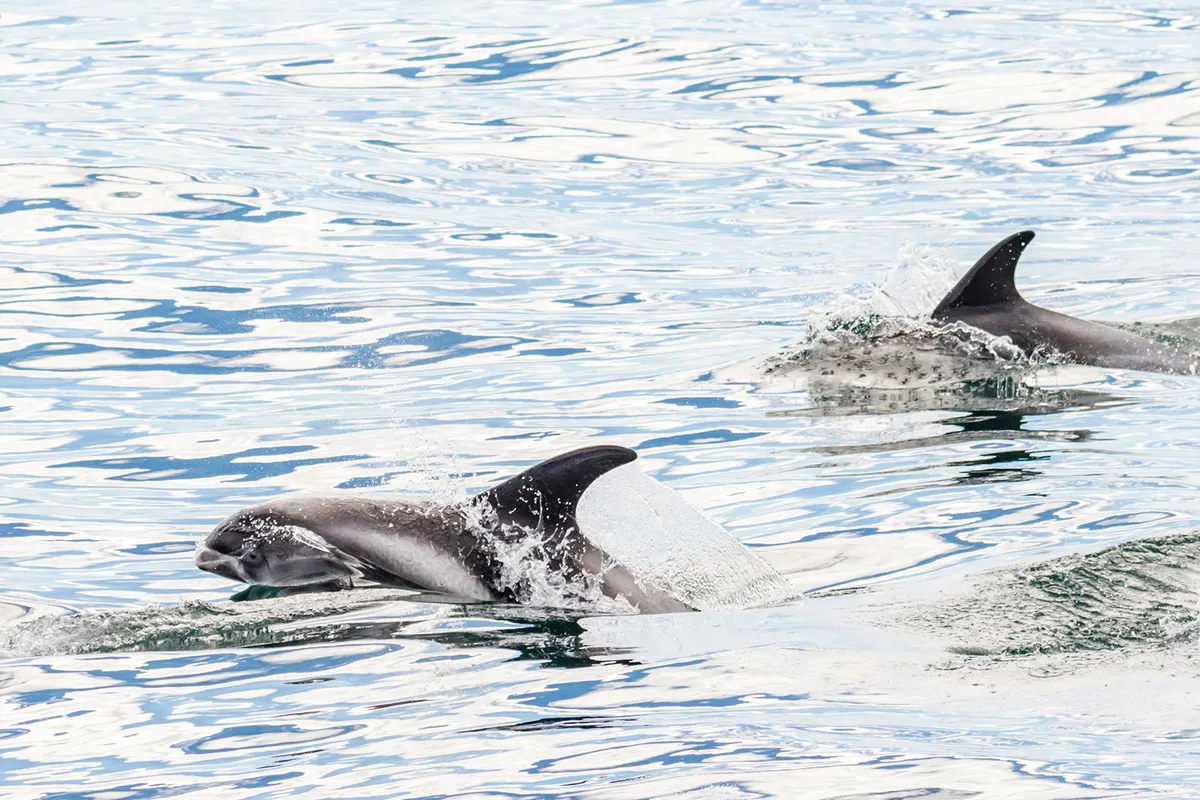
Calves of all species are initially fed their mother’s milk. The length of time they feed depends on the species.
Some species will go on to feed co-operatively, for example orca share their prey with other members of their pod.
What is the life span of whales, dolphins and porpoises?
This varies with species and can range from (averages) 12 years for a harbour porpoise to 200+ for a bowhead whale.
How do whales, dolphins and porpoises breathe?
Unlike humans, cetaceans breathe on demand and are conscious breathers (they choose/decided when to breathe and how often). They breathe air in and out through their blowholes when they surface.
How do whales, dolphins and porpoises sleep?
Cetaceans are semi-hemispheric sleepers, meaning that one half of their brain ‘sleeps’ at a time, with one half always awake. This relates back to being ‘conscious breathers’.
What do whales, dolphins and porpoises eat?
This depends on the species. Most eat a variety of different species of fish, with large baleen whales eating copious amounts of krill (some of the largest animals eating some of the smallest), other species specialising – for example Risso’s dolphins and sperm whales are suction feeders and prefer octopus and squid; and some orca populations preferring marine mammals, sharks and rays, and seabirds.
How do whales, dolphins and porpoises communicate?
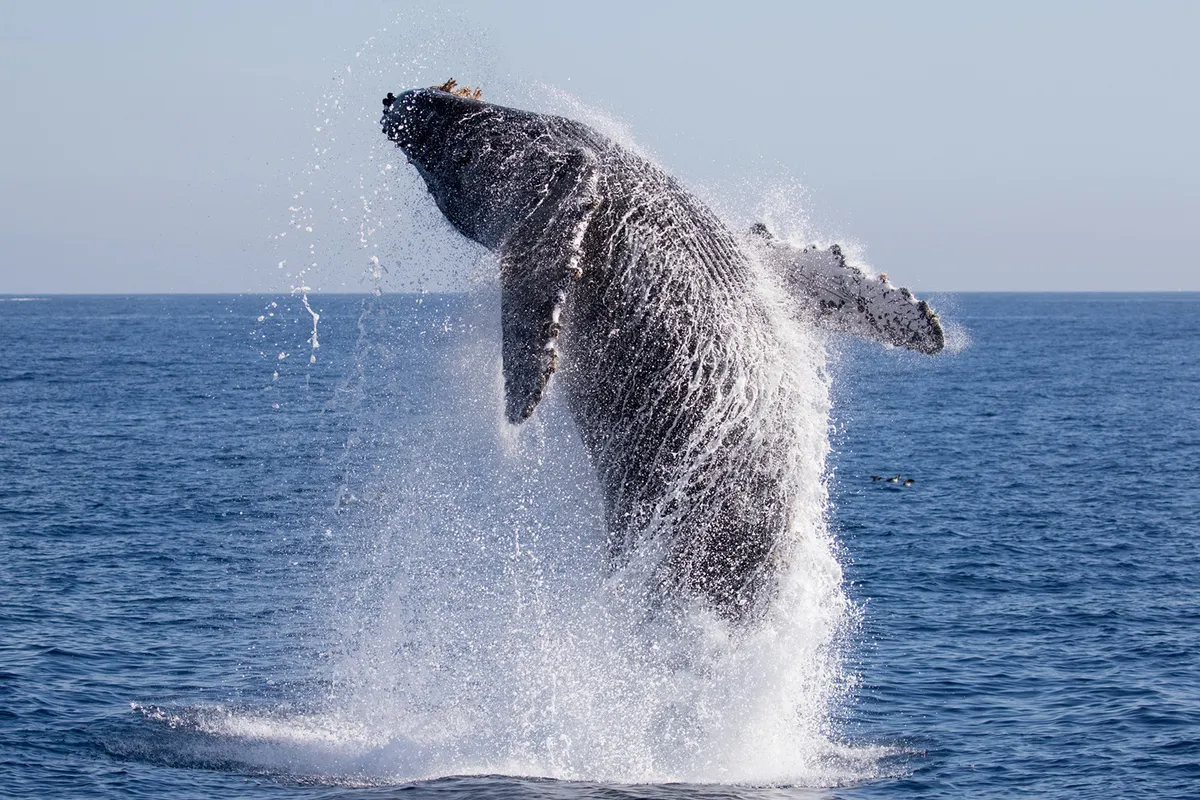
There is a lot of variation across the species. In general- high frequency sounds can pack a lot of information (think of a tightly packed bar with so many busy conversations going around) but the sounds don’t travel far so they are great for species who live in a pod structure where communication is key and everyone is hanging out in close proximity.
Low frequency sounds (as in baleen whales) travel much further but carry little information and use more energy so it’s kind of like walking alone in the woods calling for your dog, you will yell their name loudly but not carry on a full on conversation.
In short- Baleen whale communication is low frequency and travels over miles or hundreds or thousands of miles and it is purposeful but not busy (i.e. I’m a blue whale…..) whereas dolphin communication is high frequency, used in close range, and busy (my name is, I think the fish are here, there’s a shark to your left…..) so it’s all about what works best for the social structure of the species.
Do whales, dolphins and porpoises beach in the UK?
Yes, sadly they do (and are on the increase) and for a number of reasons – most of which are man-made. So, noise pollution (from underwater exploration for oil/gas, increases in boat traffic, military exercises etc will also disturb whales and dolphins and can cause them to strand.
Illness or navigational error can cause strandings, as can injury from collision with a vessel or as a result of being entangled in fishing gear.
Is there a UK national day for whales, dolphins and porpoises?
National Dolphin Day is on the 14th of April but this is only celebrated in the UK and the US (and is less known).
The International Day of Whales and Dolphins is celebrated on the 23rd of July and is celebrated globally.
Please note that external videos may contain ads:
A beautiful day for dolphins - Scottish Dolphin Centre, Spey Bay, Moray Firth, Scotland © Whale and Dolphin Conservation
